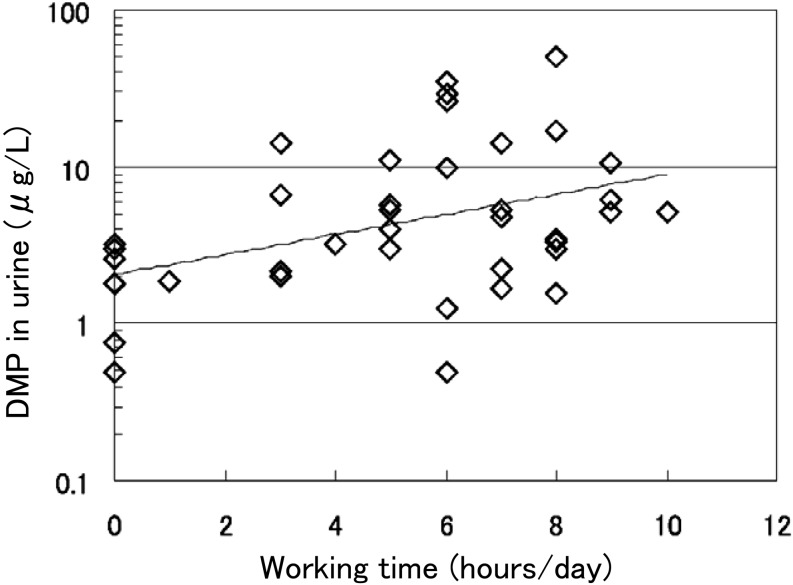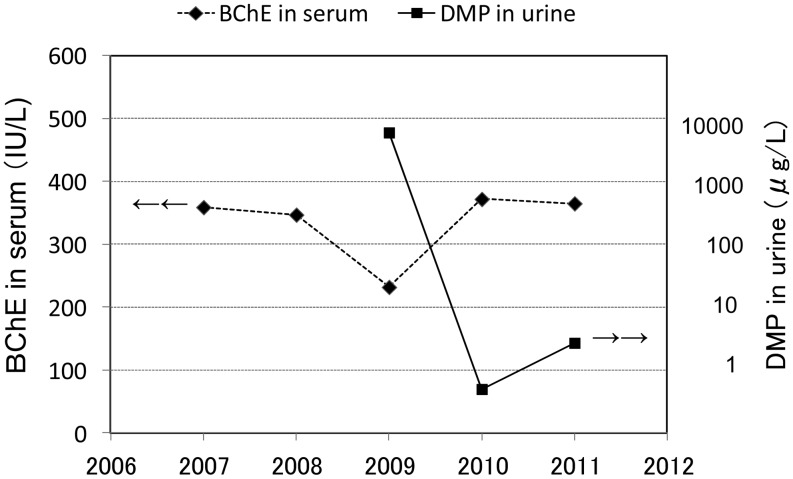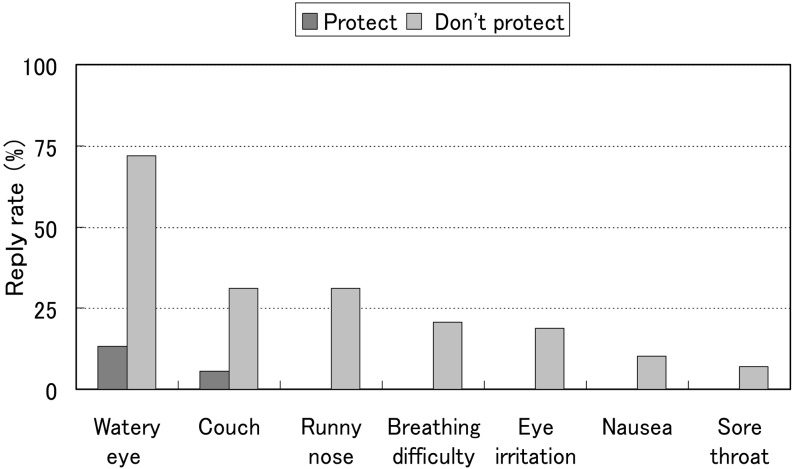Abstract
Sales of cut-flowers depend much on the outer appearance of the flowers. They are not intended to be used as foodstuffs; thus, pesticides are used more liberally for cut flower growing than for other agricultural products. Flower production is often carried out in greenhouses; therefore, pesticide exposure seems to reach not only the person spraying the pesticides, but also the non-spraying workers as well. In 2009, a special research project on pesticide poisoning, affiliated with the Japanese Association of Rural Medicine, developed a study that focused on cut-flower farmers’ exposure to pesticide, subsequent adverse symptoms experienced, and treatment modalities to relieve pesticide-related symptoms. In this group of farmers, the pesticide sprayers were almost entirely male, while the females did not do any spraying. The organophosphate metabolite level in the urine of the males was higher than that of the females. However, in the female group, a positive relation was found between average working times in the greenhouse, and urine concentration of dialkylphosphates. In 2 males of this group, the level of dimethylphosphate was detected at 1,000 times the median level. Their butyrylcholinesterase activity levels on the day of testing had declined to 64%, 72% of their average level of the proximate 4 years, respectively. Communication with these subjects regarding pesticide exposure and methods of prevention appeared to be an effective approach for reducing symptom severity. Among soil fumigants, chloropicrin and 1,3-dichloropropene were most often used. Difficulty breathing was one of the subjective symptoms associated with chloropicrin, as well as watery eyes, coughing, and runny nose. These symptoms were effectively suppressed by the preventative practice of wearing gas masks and goggles while using soil fumigants. It would be beneficial to strongly encourage use of suitable protective gear among farmers exposed to soil fumigants.
Keywords: cut-flower farmer, organophosphorus insecticide, cholinesterase activity, soil fumigant, risk communication
Introduction
Pesticides reduce the labor of farmers, and improve crop productivity. Conversely, pesticide exposure to farmers and other people causes adverse effects on occupational and environmental health. The Japanese Association of Rural Medicine (JARM) has dealt with these issues over many decades1). We are continuing an epidemiological and etiological study on collected clinical cases reported by affiliated hospitals2,3,4,5), and are also searching for an occupational health care approach for farmers.
Sales of cut-flowers depend much on their outer appearance. They are not typically used as foodstuffs; thus, pesticides are used more liberally for cut-flower growing than for other agricultural products. A JARM affiliated special research project on pesticide poisoning noticed this, and in 2009, developed and initiated a study on pesticide exposure and associated effects on cut-flower farmers in the Kyushu region of southeast Japan. We communicated several risk factors to the cut-flower farmers in order to reduce their pesticide exposure and accompanying adverse health effects.
This paper describes the outline of these studies and other related studies.
Measurement of Indices of Organophosphorus Insecticide Exposure
In late August 2009, 2010, and 2011, we measured urinary dialkylphosphates (DAP) in farmers cultivating chrysanthemums with the aid of electrical light in the northern area of the Kyushu region in southeast Japan. The number of subjects ranged from 109-112 for all three years, comprising 67–73 males, and 37–42 females. Most pesticide applications were performed by males6).
The DAP levels of this farming group were higher than DAP levels of other groups in Japan. Nakazaki et al.7) reported an interesting analysis on the DAP levels of females in this farming group.
Working Time of Females Inside Greenhouses and Concentration of Urinary DAP
Nakazaki et al.7) noticed that female farmers were not usually involved in spraying pesticide, but rather worked primarily in greenhouses. With this mind, they performed a study that, analyzing the relation between the working time of females in greenhouse and concentrations of urinary DAP. The concentrations of dimethylphosphate (DMP), diethylphosphate, and diethylthiophosphate had a significant positive relation to the working time of females in greenhouses. Figure 1 represents the relation between urinary DMP concentration and the working time of females in greenhouses (r = 0.41, p < 0.01). These results suggest that females were exposed to residual pesticides while working inside the greenhouse.
Figure 1.
Relation between working times in greenhouse and urinary dimethylphosphatases (DMP) of female cut-flower farmers.
Unfortunately, this study was underpowered due to its small subject population (n = 40), thus reducing the likelihood that a statistically significant reflects a true effect. In this respect, it would be advisable that a similar study be performed with a larger study population.
DAP in Male Urine
The concentrations of urinary DAP in the male farming group were higher than that in other groups in Japan. Urine samples from 2 males in this group showed DMP levels 1,000 times higher than the median DMP level of this group6).
Additionally, their butyrylcholinesterase activity (BChE) levels on the day of testing, had declined to 64%, 72% of their average BChE levels during the proximate 4 years, respectively.
Figure 2 shows the urinary DMP concentrations and BChE levels of male farmer for 3 and 5 years, respectively. These figures indicate that pesticide spraying procedures of the males should be revised, as suggested by the agricultural worker health system in California, USA8).
Figure 2.
Fluctuation of urinary dimethylphosphate (DMP) and butyrylcholinesterase activity (BChE) of a male cut-flower farmer.
Ueyama et al.9) measured urinary DAP levels of 101 male apple farmers. In one male from this group, DMP was detected at a level 300 times the median of the group. However, DMP exposure was not exceptionally high exposure among pest control workers.
Farms in Japan are mostly family-operated business, which makes it difficult for the agricultural worker health movement to reach farmers. Consequently, unsafe behaviors such as spraying without protective gear are common, and farmers are often exposed to high levels of pesticide as described above.
Crane et al.10) longitudinally measured a chlorpyrifos-specific metabolite, BChE, and acetyl cholinesterase activity (AChE) of pesticide sprayers engaged in cotton growing in Egypt. The level of chlorpyrifos-specific metabolite in the sprayers’ urine increased during the spraying period, while serum BChE level declined. After the spraying period, urine metabolite levels declined and serum BChE returned to normal. A decline in blood AChE lasted for several months. The average rate of decline in serum BChE for 57 sprayers during the spraying period was 70% of baseline BChE level during the pre-spraying period. Given these results, it appears necessary that agricultural workers take protect measures while spraying to minimize pesticide exposure.
Risk Communication with Heavily Exposed Persons
We discussed various risk factors with 2 males, Mr. A and Mr. B, who were heavily exposed to pesticides, in an attempt to improve behavior in pesticide spraying.
Mr. A presented to us with an unbearable cough related to pyrethroid exposure; however, he did not experience any subjective symptoms related organophosphorus exposure.
Pyrethroids are reported to have unfavorable effects on the respiratory system. Akizuki et al.11) reported a clinical case in which a fiber bronchoscopy confirmed laryngeal edema, secondary to pyrethroid exposure. A fatal case pertaining to pyrethroid exposure has also been reported; the patient was suspected to have died from complication related to laryngeal edema12). The material safety data sheet13) of pyrethroid, states as follows: “Inhalation of this chemical often results in adverse effects. Persons having a history of respiratory disease (asthma, allergy) should not be exposed”.
Considering Mr. A’s history of respiratory disease, we provided him with recommendations related to pyrethroid and its effect on human health. He decided to stop using pyrethroid insecticides, and as a result, he has been able to continue cut-flower farming.
Mr. B refused to cooperate with us, but we were able to provide him a dust mask. Per recommendation by his wife, Mr. B tried on the mask, and wore it while spraying, reportedly feeling an improvement in protection.
Risk communication with these farmers, regarding pesticide exposure and methods of prevention appeared to be an effective approach for promoting individual risk management and reducing symptom severity.
Subjective Symptoms Related to Soil Fumigants
A self-administered questionnaire, in which farmers reported subjective symptoms related to soil fumigant showed that chloropicrin was the most frequently used pesticide.
In 2012, we conducted an interview-based study on the use of soil fumigants and subjective symptoms associated with its use in 69 male cut-flower farmers14). Chloropicrin and 1,3-dichloropropene (D-D) were the most frequently used soil fumigants, followed by chloropicrin oblate, carbam, and dazomet. The subjective symptoms associated with using chloropicrin were not only watery eyes, coughing, and a runny nose, but also difficulty breathing. These symptoms were effectively suppressed by wearing protective gas masks and goggles. Figure 3 shows the subjective symptoms experienced by farmers wearing full protective gear (gas mask and goggles), some protective gear (gas mask only), or no protective gear when exposed to chloropicrin.
Figure 3.
Subjective symptoms of male cut-flower farmers on using chlorpicrin soil fumigant. Protection with gas mask and goggles: 15 males, Gas mask only: 3 males, No protection used: 29 males.
Result showed that farmers continued to work despite experiencing symptoms of watery eyes and coughing. This behavior resulted in heavy pesticide inhalation, leading to difficulty breathing.
An incident of mass poisoning from chloropicrin was reported by the United States Centers for Disease Control and Prevention15). Chloropicrin was used to fumigate land in California, and was found to run-off into a residential area. The subjective symptoms of persons residing in this particular residential area included difficulty breathing, as well as watery eyes, and coughing.
Cut-flower farmers reported dermatitis related to chloropicrin, D-D, and dazomet exposure. Dermatitis cases related to chloropicrin and D-D were mild, even when the contaminated areas were sometimes insufficiently washed. Dazomet not only causes chemical burns2), but also caused allergic dermatitis16). We interviewed a male having possible allergic dermatitis due to dazomet, and advised him to continue avoiding this fumigant.
Suppressing Emissions of Soil Fumigants with the Use of Low Permeability Films
In recent years, low permeability films have been developed for lowering the amount of soil fumigants used. As a result, the amount of fumigants released from the soil into the atmosphere has significantly decreased17,18,19,20,21). We intend to discuss this new technology, as well as the use of gas masks, when discussing risk factors with farmers.
Conclusion
We studied pesticide exposure and associated adverse effects on cut-flower farmers. We measured the urinary metabolites of organophosphorus insecticides, and interviewed on farmers regarding subjective health symptoms upon exposure to soil fumigants. Based on the results described above, it is necessary to strongly advocate wearing suitable protective gear, when exposed to pesticides. Risk communication to farmers with heavily exposed and encouragement of personal risk management appeared to be an effective approach for preventing pesticide exposure and reducing symptoms severity.
Pesticides have various properties. For example, at room temperature, soil fumigants are gaseous bodies, pyrethroids are particulate, and organophosphates are intermediated. We plan to continue providing practical information to farmers, regarding pesticide exposure and personal protective measures, and will provide them with a list of suitable protective masks.
Agricultural technology has improved regarding soil fumigants and low permeability films, in which the amount of fumigants released from the soil to the atmosphere has been greatly diminished. We intend to discuss this technology, as well as the use of gas masks, during our discussions with cut-flower farmers.
Acknowledgement
We wish to convey our gratitude to the cut-flower farmers, the growing specialists of the Japan Agriculture Cooperative Associations, and the Prefectural Agricultural Center.
References
- 1.Wakatsuki T, Yoshimoto S. Getting among farmers -- No end save health. Saku-city, Saku Central Hospital, 2003. [Google Scholar]
- 2.Horiuchi N, Oguchi S, Nagami H. Pesticide-related dermatitis in Saku district, Japan, 1975-2000. Int J Occup Environ Health 2008; 14: 25–34. doi: 10.1179/oeh.2008.14.1.25 [DOI] [PubMed] [Google Scholar]
- 3.Nagami H, Nishigaki Y, Matsushima S. Hospital-based survey of pesticide poisoning in Japan, 1998-2002. Int J Occup Environ Health 2005; 11: 180–184. doi: 10.1179/oeh.2005.11.2.180 [DOI] [PubMed] [Google Scholar]
- 4.Nagami H, Nishigaki Y, Matsushima S. Paraquat poisoning in Japan: A hospital-based Survey. J Rural Med 2007; 2: 85–92. doi: 10.2185/jrm.2.85 [DOI] [Google Scholar]
- 5.Nagami H, Maejima F, Nishigaki Y. Trends in paraquat poisoning in Japan - viewed from surveys on clinical cases. J Rural Med 2013; 8: 228–232. doi: 10.2185/jrm.2873 [DOI] [PMC free article] [PubMed] [Google Scholar]
- 6.Nagami H, Suenaga T, Nakazaki M. Monitoring of pesticide exposure in cut flower farmers and health risk: Interview with heavily exposed persons. Nihon Noson Igakkai Zasshi 2015; 64: 671–679(in Japanese, abstract in English). [Google Scholar]
- 7.Nakazaki N, Suenaga T, Nagami H. Organophosphorus pesticide exposure in flower grower. Annual Rep Toyama Inst Health 2009; 33: 123–126(in Japanese). [Google Scholar]
- 8.Lessenger JE. Fifteen years of experience in cholinesterase monitoring of insecticide applicators. J Agromed 2005; 10: 49–56. doi: 10.1300/J096v10n03_06 [DOI] [PubMed] [Google Scholar]
- 9.Ueyama J, Saito I, Kondo T. Urinary concentrations of organophosphorus insecticide metabolites in Japanese workers. Chemosphere 2012; 87: 1403–1409. doi: 10.1016/j.chemosphere.2012.02.048 [DOI] [PubMed] [Google Scholar]
- 10.Crane AL, Abdel Rasoul G, Ismail AA. Longitudinal assessment of chlorpyrifos exposure and effect biomarkers in adolescent Egyptian agricultural workers. J Expo Sci Environ Epidemiol 2013; 23: 356–362. doi: 10.1038/jes.2012.113 [DOI] [PMC free article] [PubMed] [Google Scholar]
- 11.Akizuki H, Iwasaki H, Takeichi A. Pharyngolaryngeal edema caused by pyrethroid: A case report. Tokushima Red Cross Hospital Medical Journal 2013; 18: 47–51(in Japanese, abstract in English). [Google Scholar]
- 12.Naito H. Poisoning of Industirial Products, Gases, Pesticides, Drugs, and Natural Toxines. Tokyo: Nankodo 2001; 241–242: 256.(in Japanese). [Google Scholar]
- 13.Corporation CBC. Material safety data sheet -- Ardent wettable powder. Tokyo: Bayer Cropscience, 2011: 5. <https://www.bayercropscience.co.jp/pdf/msds/18953.pdf> (in Japanese).
- 14.Nagami H, Suenaga T, Nakazaki M. Use of soil fumigants and subjective symptoms of cut flower farmers -- A survey by interview. Nihon Noson Igakkai Zasshi 2014; 63: 41–48(in Japanese, abstract in English). [Google Scholar]
- 15.Centers for Disease Control and Prevention (CDC)Illness associated with drift of chloropicrin soil fumigant into a residential area -- Kern County, California, 2003. MMWR Morb Mortal Wkly Rep 2004; 53: 740–742. [PubMed] [Google Scholar]
- 16.Ohata C, Yoneda M. Allergic contact dermatitis due to dazomet absorbed by agricultural rubber boots. Acta Derm Venereol 2013; 93: 81–82. doi: 10.2340/00015555-1323 [DOI] [PubMed] [Google Scholar]
- 17.Shimizu E, Masuda D, Nishimura K. Effect of fumigation using virtually impermeable film on suppression of injury derived from root-knot nematode of melon in sand dune areas. Annual Rep Ishikawa Agric Res Cent 2006; 27: 25–31(in Japanese, abstract in English). [Google Scholar]
- 18.Yonemoto K, Tanaka A, Sakaguchi K. Reduction of soil fumigants emissions using low permeability film by the method of applying to mulched row and control effect of sweet potato soil rot. Annual Rep Tokushima Agric, Foresty. Fish Tech Supp Cent 2008; 5: 45–51(in Japanese). [Google Scholar]
- 19.Gao S, Sosnoskie LM, Cabrera JA. Fumigation efficacy and emission reduction using low-permeability film in orchard soil fumigation. Pest Manag Sci 2016; 72: 306–314. doi: 10.1002/ps.3993 [DOI] [PubMed] [Google Scholar]
- 20.Qin R, Gao S, Thomas JE. Emissions from soil fumigation in two raised bed production systems tarped with low permeability films. Chemosphere 2013; 93: 1379–1385. doi: 10.1016/j.chemosphere.2013.06.068 [DOI] [PubMed] [Google Scholar]
- 21.Tanaka A, Murai K, Yonemoto K. Promotion activity of environment conscious chloropicrin soil fumigation techniques in sweet potato production districts of Tokushima. Jpn J Pesticide Sci 2015; 40: 76–80(in Japanese). doi: 10.1584/jpestics.W14-41 [DOI] [Google Scholar]





